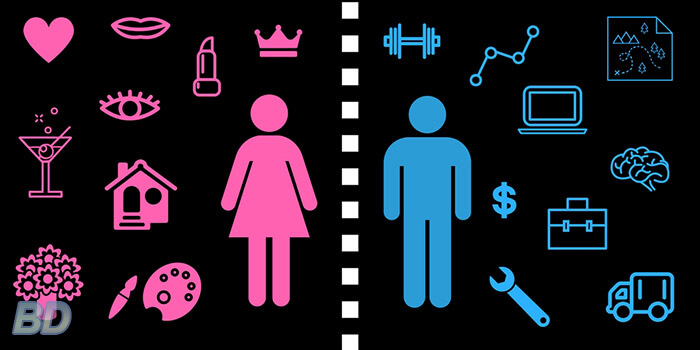Modern society is used to thinking stereotyped and dividing traditional female gender roles and male ones. When meeting for the first time, many people are mistaken when they begin to ascribe to a person some qualities without delving into whether he or she has them or not. Such stereotypes are formed due to social roles. But everything should be based solely on conventional wisdom. You can’t let stereotypes influence your life and perception of the world. So, let’s figure out how society sees gender roles in our time.
 k
k
What Are Traditional Gender Roles?
In modern sociology, this concept has two meanings. In the first case, it is understood as the way in which people express their gender identity. In some cases, people find it difficult to identify themselves with some sex, alternately playing the role of a man and then the role of a woman. Then they use the term “third sex” or talk about transgender people. In the second meaning, a gender role implies a set of different types of behavior, activities or functions that a person has to perform, who has already decided on his/her gender identity.
Traditional relationship roles have changed over time. Moreover, humanity is changing too. The gender role of men and women is also undergoing changes. It is instilled in society by teaching from childhood a certain behavior pattern inherent in one or another sex. These stereotypes of behavior lead to misunderstanding between the sexes and conflicts, and as a result, make people unhappy. Consider now some examples of traditional gender roles: a man was a hunter, leader, warrior with such traits as self-confidence, good appetite, aggression, and speed of reaction.
A woman was always distinguished by gentleness, compassion, care, and was engaged only in keeping a house and bringing up the next generation. Of course, the time leaves its mark on the stereotypes of behavior, so it is rarely possible to meet a truly feminine or masculine behavior in a pure form nowadays.
Traditional Gender Roles of Women
Usually, traditional female roles appear when a girl is born. When parents get to know that they will have a girl, they immediately begin to paint her room with the pink color, fill it with flowers and Barbie dolls. They believe that a child will be a typical “girl” and buy her dresses, toys, and so on. They teach their girls that they have to wear beautiful clothes, cook food, and take care of future children. Even at the age of five or six, a girl well understands that her task will be to sit at home and spend time with her child while her husband will go to work, so dinner should be ready before he comes home. Here are some other views on traditional women’s roles.
- They should have “easy jobs;”
- They can’t be businesswomen;
- They can’t get a good education;
- They can’t achieve success in different spheres of life;
 They can’t govern;
They can’t govern;- They should obey men;
- They should cook;
- They should raise children;
- They should look beautiful;
- They should never approach a man first to get acquainted.
All this means that women’s problems include low wages, low status, and small power opportunities, as well as household chores. Of course, it doesn’t mean that women should strive for absolute gender equality. In certain situations, it is still worthwhile to leave the privilege to men to be strong and courageous, and women should be gentle, weak, and feminine.
Traditional Gender Roles of Men
From childhood, boys are taught to be strong and protect themselves. Most people say that they don’t teach their boys how to do the dishes or clean the house. Instead of it, they teach them to do some hard work in the house, for example, to put up shelves, giving the rest of the housework to women. They have to do the work that requires muscles. This is the main stereotype, but most families live this way. Men also have to provide for their families. Boys understand this and follow such rules. Other traditional gender roles of men include the following moments.
- They should like cars;
- They do “male work;”
- They don’t look after children;
- They are better at sports;
- They like to go fishing or hiking;
- They should be responsible for their families;
- They should tell their women how to behave and what to do;
- They can’t cook.
As you can see, there is nothing bad in the traditional gender roles of men and women. But our world is constantly changing, and people can be successful in any sphere of life. And at present, no one will blame you if you are a man and perform women’s duties and vice versa.
Countries with Traditional Gender Roles
Should women do all the housework? Should they be more concerned about the husband’s career than their own? Should men provide for their families? Some may agree with these statements, some may not. There are different countries and cultures. There are four aspects on which gender roles depend:
- Different work;
- Different beliefs or stereotypes;
- Differential socialization of boys and girls;
- Different status of women in society.
In each country, there is a different understanding of female and male roles. Historically, in almost any culture, women and men perform different work, but the specific types of work performed by different sexes don’t always coincide. This indicates the hypothesis that gender roles are formed by people and their culture. People from, Ukraine, Russia, Belarus, Kazakhstan and other countries like Nigeria or Pakistan have more traditional family roles. At the same time, such countries as France, Italy, Spain, China, Portugal live by the new “rules” – feminism prevails in these countries, so women are ready to take on male roles and responsibilities.
Statistics of traditional gender roles in America is still controversial. Although women and men there prefer equal rights, many women say that they are not ready to do men’s work and feel good in the role of housewives. For now, it can be said that Slavic culture is more prone to a traditional way of life where a man is the head of the family and a woman is a homemaker.
Have Gender Roles Become Outdated?
Even children know about traditional gender roles in society. They understand that girls are much quieter than boys, they are more careful and diligent in their studies, they have a tendency to learn languages and literature, and they must be able to cook, sew and clean. Girls must be obedient, responsive and quiet because they are preparing to become wives, mothers, and homemakers. At this time, boys are inculcated with stamina and independence. They are taught to rely on their own strength and achieve their goals by all means. However, in practice, girls don’t always want to be quiet and empathetic, and boys can be weak in different life situations. The traditional view of gender roles prohibits a boy to show emotions because he is a “man” and “men don’t cry,” while a girl, on the contrary, is allowed to be sensitive, but her experiences are attributed to “female nature.”
 At all times, society has demarcated clear boundaries between people’s behavior and functions, but the understanding of purely male and female activities is quite different today. In the past thirty years, the theory of gender equality has strengthened in the countries of Western civilization, thanks to which the Western world gradually gets rid of stereotypes, traditional marriage roles, so it equalizes women and men. This is prescribed in a multitude of international documents, ensuring people that they have equal access to social and material benefits, including education and health care.
At all times, society has demarcated clear boundaries between people’s behavior and functions, but the understanding of purely male and female activities is quite different today. In the past thirty years, the theory of gender equality has strengthened in the countries of Western civilization, thanks to which the Western world gradually gets rid of stereotypes, traditional marriage roles, so it equalizes women and men. This is prescribed in a multitude of international documents, ensuring people that they have equal access to social and material benefits, including education and health care.
Such a theory was based on numerous studies proving that most of the features previously attributed to particular sex actually depend on the social environment in which the personality is brought up. Also, it was proved that the brains of men and women have certain differences, but, for example, there is no difference in analytical capabilities. Moreover, it was found that a harmoniously developed mature personality combines both male and female features equally. So, once again, there are no clear boundaries and divisions between responsibilities in our time. Everyone should live by personal feelings.
Non-Traditional Gender Roles
A woman is a wife and mother, therefore, from this point of view, her gender status is a housewife, a caretaker of her family, a caring mother of children, etc. According to tradition, such a woman gives her time and emotions to the family and perceives her place and role in society as a natural thing, i.e. takes everything for granted. The status of a man, on the contrary, includes the role of a breadwinner, an employee, a consumer of household services who doesn’t deal with children but takes care of the family financially.
Roles and their perception are reflected in the multitude of stereotypes of the mass consciousness, for example, it means that men can’t show tenderness and affection for the child because they are less emotional, and women are happy when they don’t have work outside the home, and so on. The modern approach recognizes the equal rights and opportunities of people to work and build a career. Both a husband and a wife can equally bring up children, showing affection, care and attention towards them.
According to this approach, in modern society, the reverent attitude to a child by a man is no different from a woman’s approach. The young generation of people certainly appreciates the modern model of gender roles, in which equal gender relations prevail. There is already a trend towards gender equality. And this leads to positive results all over the world.
From the foregoing, it can be concluded that gender differences are not as big as it is commonly believed. Our gender roles are influenced by a huge number of external factors. We observe the behavior of our parents and other adults, trying to imitate the people of our gender, play certain games. The media create stereotypes in our society, which we can’t ignore. We grow up, conforming to our roles. We try to be real men or real women, not always agreeing with what the society prescribes.
Your Comment
Log In Or Sign Up
To Leave Your Comment